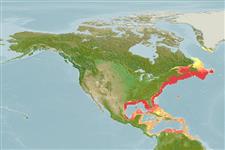Classificação / Names
Common names from other countries
Referência principal
Tamanho / Peso / Idade
Max length : 152 cm TL macho/indeterminado; (Ref. 26938); 122.0 cm TL (female); common length : 50.0 cm TL macho/indeterminado; (Ref. 3242); Peso máx. publicado: 7.3 kg (Ref. 4699); Idade máx. registada: 43 anos (Ref. 40922)
Length at first maturity
Lm ?, range 37 - 100 cm
Ambiente
; marinhas; Água doce; estuarina demersal; catádromos (Ref. 26938); intervalo de profundidade 0 - 464 m
Clima / Intervalo
Subtropical; 4°C - 25°C (Ref. 12468), preferred 7°C (Ref. 107945); 66°N - 7°N, 98°W - 21°W
Distribuição
Descrição suscinta
Espinhos dorsais (total): 0; Espinhos anais 0. Head rather long; eyes small and placed well forward on head. Lips thick. Caudal vertebrae without transverse processes. Premaxillae not developed as distinct elements in adults. Frontal bones paired, not grown together. Pectoral girdle with 7 to 9 (up to 11 in the young) radial elements. Adults usually white or light-colored below and brownish to blue-black above, but coloration is variable; young with some yellow on the edges of the dorsal and anal fins (Ref. 30499). Caudal fin rounded, joined to dorsal and anal fins. Gill opening on side in front of lower half of well-developed pectoral fin; lower jaw longer than upper; 103-111 vertebrae (Ref. 26938).
Status na Lista Vermelha da IUCN (Ref. 115185)
Perigo para os humanos
Harmless
Uso pelos humanos
Pescarias: espécies comerciais; Aquacultura: espécies comerciais; peixe esportivo: sim; Aquário: Aquários públicos
Ferramentas
Relatórios especiais
Baixar XML
Fontes da internet
Estimates of some properties based on models
Phylogenetic diversity index
PD50 = 0.5000 many relatives (e.g. carps) 0.5 - 2.0 few relatives (e.g. lungfishes)
Nível Trófico
3.8 ±0.2 se; Based on diet studies.
Resiliência
Médio, tempo mínimo de duplicação da população 1,4 - 4,4 anos (tm=3-6; Fec=5,000,000)
Vulnerabilidade
Very high vulnerability (83 of 100)
Categoria de preço
